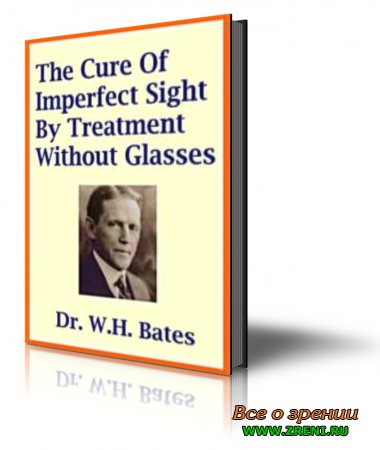The Cure of Imperfect Sight by Treatment Without Glasses | Bates W. H., M.D.
Автор: Bates W.H.
Год: 1920
Издательство: University of Toronto
Формат: PDF
Качество: The scanned pages
Количество страниц: 337
Описание
Do you read imperfectly?
Can you observe then that when you look at the first word, or the first letter, of a sentence you do not see best where you are looking; that you see other words, or other letters, just as well as or better than the one you are looking at?
Do you observe also that the harder you try to see the worse you see?
Now close your eyes and rest them, remembering some color, like black or white, that you can remember perfectly. Keep them closed until they feel rested, or until the feeling of strain has been completely relieved. Now open them and look at the first word or letter of a sentence for a fraction of a second. If you have been able to relax, partially or completely, you will have a flash of improved or clear vision, and the area seen best will be smaller.
After opening the eyes for this fraction of a second, close them again quickly, still remembering the color, and keep them closed until they again feel rested. Then again open them for a fraction of a second. Continue this alternate resting of the eyes and flashing of the letters for a time, and you may soon find that you can keep your eyes open longer than a fraction of a second without losing the improved vision.
If your trouble is with distant instead of near vision, use the same method with distant letters.
In this way you can demonstrate for yourself the fundamental principle of the cure of imperfect sight by treatment without glasses.
If you fail, ask someone with perfect sight to help you.
Preface
This book aims to be a collection of facts and not of theories and insofar as it is, I do not fear successful contradiction. When explanations have been offered it has been done with considerable trepidation, because I have never been able to formulate a theory that would withstand the test of the facts either in my possession at the time, or accumulated later.
The same is true of the theories of every other man, for a theory is only a guess, and you cannot guess or imagine the truth.
No one has ever satisfactorily answered the question, "Why?" as most scientific men are well aware, and I did not feel that I could do better than others who had tried and failed. One cannot even draw conclusions safely from facts, because a conclusion is very much like a theory, and may be disproved or modified by facts accumulated later. In the science of ophthalmology, theories, often stated as facts, have served to obscure the truth and throttle investigation for more than a hundred years.
The explanations of the phenomena of sight put forward by Young, von Graefe, Helmholtz and Donders have caused us to ignore or explain away a multitude of facts which otherwise would have led to the discovery of the truth about errors of refraction and the consequent prevention of an incalculable amount of human misery.
In presenting my experimental work to the public, I desire to acknowledge my indebtedness to Mrs. E. C. Lierman, whose co-operation during four years of arduous labor and prolonged failure made it possible to carry the work to a successful issue. I would be glad, further, to acknowledge my debt to others who aided me with suggestions, or more direct assistance, but am unable to do so, as they have requested me not to mention their names in this connection.
As there has been a considerable demand for the book from the laity, an effort has been made to present the subject in such a way as to be intelligible to persons unfamiliar with ophthalmology.
Contents
Preface
CHAPTER I Introductory
Prevalence of errors of refraction—Believed to be incurable and practically unpreventable—The eye regarded as a blunder of Nature—Facts which seem to justify this conclusion—Failure of all efforts to prevent the development of eye defects—Futility of prevailing methods of treatment—Conflict of facts with the theory of incurability of errors of refraction—These facts commonly explained away or ignored—The author unable to ignore them, or to accept current explanations— Finally forced to reject accepted theories.
CHAPTER II Simultaneous Retinoscopy
Retinoscopy the source of much of the information presented in this book—What the retinoscope is—Its possibilities not realized—Commonly used only under artificial conditions—Used by the author under the conditions of life on human beings and the lower animals— Thus many new facts were discovered—Conflict of these facts with accepted theories—Resulting investigations.
CHAPTER III Evidence For the Accepted Theory of Accommodation
Development of the theory—Behavior of the lens in accommodation as noted by Helmholtz—General acceptance of these observations as facts—Abandonment by Arlt of the true explanation of accommodation— Inability of Helmholtz to explain satisfactorily the supposed change of form in the lens—Question still unsettled—Apparent accommodation in lenseless eyes—Curious and unscientific theories advanced to account for it —Voluntary production of astigmatism—Impossibility of reconciling it with the theory of an inextensible eyeball.
CHAPTER IV The Truth About Accommodation As Demonstrated By Experiments on the Eye Muscles of Fish, Cats, Dogs, Rabbits and Other Animals
Disputed function of the external muscles of the eyeball—Once regarded as possible factors in accommodation—This idea dismissed after supposed demonstration that accommodation depends upon the lens—Author's experiments demonstrate that accommodatjon depends wholly upon these muscles—Accommodation prevented and produced at will by their manipulation— Also errors of refraction—The oblique muscles of accommodation—The recti concerned in the production of hypermetropia and astigmatism—No accommodation with one oblique cut, paralyzed, or absent—Paralysis of accommodation in experimental animals accomplished only by injection of atropine deep into the orbit, so as to reach the oblique muscles — Accommodation unaffected by removal of the lens—Fourth cranial nerve supplying superior oblique muscle a nerve of accommodation—Sources of error believed to have been eliminated in experiments.
CHAPTER V The Truth About Accommodation As Demonstrated By a Study of Images Reflected From the Cornea, Iris, Lens and Sclera
Technique of Helmholtz defective—Image obtained by his method on the front of the lens not sufficiently distinct or stable to be measured—Failure of author to get reliable image with various sources of light—Success with 1,000-watt lamp, diaphragm and condenser— Image photographed—Images on cornea, iris, lens and sclera also photographed — Results confirmed earlier observations—Eyeball changes its shape during accommodation—Lens does not—Strain to see at near-point produces hypermetropia—Strain to see at distance myopia—Method of obtaining the corneal image.
CHAPTER VI The Truth About Accommodation As Demonstrated By Clinical Observations
Results of experimental work confirmed by clinical observations—Atropine supposed to prevent accommodation—Conflict of facts with this theory—Normal accommodation observed in eyes under influence of atropine for long periods—Evidence of these cases against accepted theories overwhelming—Cases of accommodation in lenseless eyes observed by author—Reality of the apparent act of accommodation demonstrated by the retinoscope—Evidence from the cure of presbyopia— Harmony of all clinical observations with views of accommodation and errors of refraction presented in this book.
[banner_centerrs] {banner_centerrs} [/banner_centerrs]
CHAPTER VII The Variability of the Refraction of the Eye
Refractive states supposed to be permanent—Retinoscope demonstrates the contrary—Normal sight never continuous—Refractive errors always changing—Conditions which produce errors of refraction—Variability of refractive states the cause of many accidents—Also of much statistical confusion.
CHAPTER VIII What Glasses Do to Us
The sins of Salvino degli Armati reputed inventor of spectacles—How glasses harm the eyes—Sight never improved by them to normal—Always resented at first by the eye—Objects of vision distorted by them—Disagreeable sensatoins produced—Field of vision contracted—Difficulty of keeping the glass clean—Reflection of light from lenses annoying and dangerous— Inconvenience of glasses to physically active persons— Effect on personal appearance—No muscular strain relieved by them—Apparent benefits often due to mental suggestion—Fortunate that many patients refuse to wear them—At best an unsatisfactory substitute for normal sight.
CHAPTER IX Cause and Cure of Errors of Refraction
All abnormal action of external muscles of the eyeball accompanied by a strain to see — With relief of this strain all errors of refraction disappear—Myopia (or lessening of hypermetropia) associated with strain to see at the distance — Hypermetropia (or lessening of myopia) associated with strain to see at the near-point —Facts easily demonstrated by retinoscope—Effect of strain at the near-point accounts for apparent loss of accommodation in the lenseless eye—Mental origin of eyestrain—Accounts for effect of civilization on the eye —Lower animals affected as man is—Remedy to get ridof mental strain—Temporary relaxation easy—Permanent relaxation may be difficult—Eyes not rested by sleep or tired by use—Rested only by resting the mind —Time required for a cure.
CHAPTER X Strain
Foundation of the strain to see—Act of seeing passive —Same true of action of all sensory nerves—Their efficiency impaired when made the subject of effort—The mind the source of all such efforts brought to bear upon the eye—Mental strain of any kind produces eyestrain— This strain takes many forms—Results in production of many abnormal conditions — Circulation disturbed by strain—Normal circulation restored by mental control— Thus errors of refraction and other abnormal conditions are cured.
CHAPTER XI Central Fixation
"The center of sight—The eye normally sees one part of everything it looks at best—Central fixation lost in all abnormal conditions of the eye—Cause of mental strain —With central fixation the eye is perfectly at rest—Can be used indefinitely without fatigue—Open and quiet— No wrinkles or dark circles around it—Visual axes parallel—With eccentric fixation the contrary is the case— Eccentric fixation cured by any method that relieves strain—Limits of vision determined by central fixation— Organic diseases relieved or cured by it—No limit can be set to its possibilities—Relation to general efficiency and general health.
CHAPTER XII Palming
Relaxation with the eyes shut—With light excluded by palms of the hands (palming)—Evidence of complete relaxation in palming—Of incomplete relaxation—Difficulties of palming—How dealt with—Futility of effort— All the sensory nerves relaxed by successful palming— Pain relieved in all parts of the body—Patients who succeed at once are quickly cured—A minority not helped and should try other methods.
CHAPTER XIII Memory As an Aid to Vision
Memory a test of relaxation—-Memory of black most suitable for the purpose—Application of this fact to treatment of functional eye troubles—Sensation not a reliable index of strain—Memory of black is—Enables the patient to avoid conditions that produce strain— Conditions favorable to memory—Retention of memory under unfavorable conditions—Quick cures by its aid—A great help to other mental processes—Tests of a perfect memory.
CHAPTER XIV Imagination As an Aid to Vision
Retinal impressions interpreted by the mind—Memory or imagination normally used as an aid to sight—In imperfect sight the mind adds imperfections to the imperfect retinal image—Only a small part of the phenomena of refractive errors accounted for by the inaccuracy of the focus—Difference between the photographic picture when the camera is out of focus and the visual impressions of the mind when the eye is out of focus—Patients helped by understanding of this fact—Dependence of imagination upon memory—Coincidence of both with sight—Perfect imagination dependent upon relaxation— Therefore imagination cures—Method of using it for this purpose—Remarkable cures effected by it.
CHAPTER XV Shifting and Swinging
Apparent movement of objects regarded with normal vision—Due to unconscious shifting of the eye—Impossibility of fixing a point for an appreciable length of time—lowering of vision bv attempt to do so—Incon-spicuousness of normal shitting—Its incredible rapidity —Staring an important factor in the production of imperfect sight—Tendency to stare corrected by conscious shifting and realization of apparent movement resulting from it—Conditions of success with shifting—The universal swing—Methods of shifting—Cures effected by this means.
CHAPTER XVI The Illusions of Imperfect and of Normal Sight
Normal and abnormal illusions—Illusions of color— Of size—Of form—Of number—Of location—Of nonexistent objects—Of complementary colors—Of the
color of the sun—Blind spots—Twinkling stars—Cause of illusions of imperfect sight—Voluntary production of illusions—Illusions of central fixation—Normal illusions of color—Illusions produced by shifting—The up* right position of objects regarded an illusion.
CHAPTER XVII Vision Under Adverse Conditions a Benefit to the Eye
Erroneous ideas of ocular hygiene—Conditions supposedly injurious may be a benefit to the eye—No foundation for universal fear of the light—Temporary discomfort but no permanent injury from it—Benefits of sun-gazing—Of looking at a strong electric light—Not light but darkness a danger to the eye—Sudden contrasts of light may be beneficial—Advantages of the movies—Benefits of reading fine print—Reading in moving vehicles—In a recumbent posture—Vision under difficult conditions good mental training.
CHAPTER XVIII Optimums and Pessimums
All objects not seen equally well when sight is imperfect—The eye has its optimums and pessimums—Some easily accounted for — Others unaccountable — Familiar objects optimums—Unfamiliar objects pessimums—Examples of unaccountable optimums and pessimums— Variability of optimums and pessimums—Test card usually a pcssimum—Pessimums which the patient is not conscious of seeing—Pessimums associated with a strain to see—How pessimums may become optimums.
CHAPTER XIX The Relief of Pain and Other Symptoms by the Aid of the Memory
No pain felt when the memory is perfect—All the senses improved—Efficiency of the mind increased— Operations performed without anaesthetics—Organic disorders relieved—Facts not fully explained, but attested by numerous proofs—Possible relationship of the principle involved to cures of Faith Curists and Christian Scientists.
CHAPTER XX Presbyopia: Its Cause and Cure
Failure of near vision as age advances—Supposed normality of this phenomenon—Near-points expected at different ages—Many do not fit this schedule—Some never become presbyopic—Some retain normal vision for some objects while presbyopic for others—First and second of these classes of cases explained away or ignored—Third not heretofore observed—Presbyopia both preventable and curable—Due to a strain to see at the near-point—No necessarv connection with age—Lens may flatten and lose retractive power with advancing years, but not necessarily—Temporary increase of presbyopia by strain at the near-point—Temporary relief by closing the eyes or palming—Permanent relief by permanent relief of strain—How the author cured himself— Other cures—Danger of putting on glasses at the presbyopic age—Prevention of presbyopia.
CHAPTER XXI Squint and Amblyopia: Their Cause
Definition of squint—Theories as to its cause—Failure of these theories to fit the facts—Failure of operative treatment—St?'e of the vision not an important factor— Amblyopia ex anopsia—Association with squint not invariable—Supposed incurability—Spontaneous recovery —Curious forms of double vision in squint—Invariable association of squint and amblyopia with strain—Invariable relief following relief of strain—Voluntary production of squint by strain.
CHAPTER XXII Squint and Amblyopia: Their Cure
Squint and amblyopia purely functional troubles— Cured by any method that relieves strain—Relaxation sometimes gained by voluntary increase of squint, or production of other kinds—Remarkable cure effected in this way—Strain relieved when patient is able to look more nearly in the proper direction—Proper use of a squinting eye encouraged by covering the good eye— Children cured by use of atropine in one or both eyes— Examples of cases cured by eye education.
CHAPTER XXIII Floating Specks: Their Cause and Cure
Floating specks a common phenomenon of imperfect sight—Their appearance and behavior—Theories as to their origin—A fruitful field for the patent-medicine business—Examples of the needless alarm they have caused—May be seen at times by any one—Simply an illusion caused by mental strain—This strain easily relieved—Illustrative cases.
CHAPTER XXIV Home Treatment
Many persons can cure themselves of defective sight— Only necessary to follow a few simple directions—How to test the sight—Children who have not worn glasses cured by reading the Snellen test card every day—Adults of the same class also benefited in a short time—Cases of adults and children who have worn glasses more difficult—Glasses must be discarded—How to make a test card—Need of a teacher in difficult cases—Qualifications of such teachers—Duty of parents.
CHAPTER XXV Correspondence Treatment
Correspondence treatment usually regarded as quackery —Impossible in the case of most diseases—Errors of refraction, not being diseases, admit of such treatment— Glasses successfully fitted by mail—Less room for failure in correspondence treatment of imperfect sight without glasses—Personal treatment more satisfactory, but not always available—Examples of cases cured by correspondence—Need for the co-operation of local practitioners in such treatment.
CHAPTER XXVI The Prevention of Myopia in Schools: Methods That Failed
A much debated question—Literature on the subject voluminous and unreliable—All that is certainly known —Studies of Cohn—Confirmation of his observations by other investigators in America and Europe—Increase of myopia during school life unanimously attributed to near work—Inadequacy of this theory—Failure of preventive measures based upon it—New difficulties—The appeal to heredity—To natural adaptation—Objections to these views—Why all preventive measures have failed.
CHAPTER XXVII The Prevention and Cure of Myopia and Other Errors of Refraction in Schools: A Method That Succeeded
Production of eyestrain by unfamiliar objects—Relief by familiar objects—Facts furnish the means of preventing and curing errors of refraction in schools—By this means children often gain normal vision with incredible rapidity—Results in schools of Grand Forks, N. D.; New York, and other cities—Improvement in mentality of children as eyesight improved—Reformation of truants and incorrigibles—Hypermetropia and astigmatism prevented and cured—Method succeeded best when teachers did not wear glasses—Success would be greater still under a more rational educational system—Prevalence of defective sight in American children—Its results —Practically all cases preventable and curable—Inex-pensiveness of method recommended—Imposes no additional burden on the teachers—Cannot possibly hurt the children—Directions for its use.
CHAPTER XXVIII The Story of Emily
Cure of defective eyesight by cured patients—Cures of fellow students, parents and friends by school chil- # dren—Remarkable record of Emily—An illustration of the benefits to be expected from the author's method of preventing and curing imperfect sight in school children.
CHAPTER XXIX Mind and Vision
Poor sight one of the most fruitful causes of retardation in schools—More involved in it than inability to see —The result of an abnormal condition of the mind— This cannot be changed by glasses—Memory among faculties impaired when vision is impaired—Memory of primitive man may have been due to the same cause as his keen vision—A modern example of primitive memory combined with primitive keenness of vision—Correspondence between differences in the faculty of memory and differences in visual acuity—Memory and eyesight of children spoiled by the same causes—Both dependent upon interest—Illustrative cases—All the mental faculties improved when vision becomes normal—Examples of such improvement—Relief of symptoms of insanity by eye education—Facts indicate a close relation between the problems of vision and those of education.
CHAPTER XXX Normal Sight and the Relief of Pain for Soldiers and Sailors
Growth of militarism in the United States—Demand for universal military training—Lack of suitable material for such training—Defective eyesight greatest impediment to the raising of an efficient army—None more easily removed—Plan for correcting defects of vision submitted to Surgeon General during the war—Not acted upon—Now presented to the public with some modifications—First requisite eye education in schools and colleges—Eye education in training camps and at the front also needed, even for those whose sight is normal—How school system might be modified for military and naval use—Soldiers should not be allowed to wear glasses—Importance of eye training to aviators— Eye training for the relief of pain.
CHAPTER XXXI Letters from Patients
Army officer cures himself—A teacher's experiences— Mental effects of central fixation—Relief after twenty-five years—Search for myopia cure rewarded—Facts versus theories—Cataract relieved by central fixation.
CHAPTER XXXII Reason and Authority
Inaccessibility of average mind to reason—Facts discredited if contrary to authority—Patients discredit their own experience under this influence—Cure of cataract ignored by medical profession—Expulsion of author from N. Y. Post Graduate Medical School for curing myopia—Man not a reasoning being—Consequences to the world.
Купить или скачать книгу
Все файлы на сайте, прежде чем выкладываются, проверяются на вирусы. Поэтому мы даем 100% гарантию чистоты файлов.





Комментариев 0